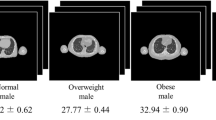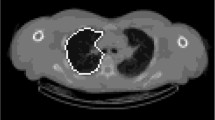Abstract
Objectives
To compare CT lung volumetry (CTLV) measurements provided by different software packages, and to provide normative data for lung densitometric measurements in healthy individuals.
Methods
This retrospective study included 51 chest CTs of 17 volunteers (eight men and nine women; mean age, 30 ± 6 years), who underwent spirometrically monitored CT at total lung capacity (TLC), functional residual capacity (FRC), and mean inspiratory capacity (MIC). Volumetric differences assessed by four commercial software packages were compared with analysis of variance (ANOVA) for repeated measurements and benchmarked against the threshold for acceptable variability between spirometric measurements. Mean lung density (MLD) and parenchymal heterogeneity (MLD-SD) were also compared with ANOVA.
Results
Volumetric differences ranged from 12 to 213 ml (0.20 % to 6.45 %). Although 16/18 comparisons (among four software packages at TLC, MIC, and FRC) were statistically significant (P < 0.001 to P = 0.004), only 3/18 comparisons, one at MIC and two at FRC, exceeded the spirometry variability threshold. MLD and MLD-SD significantly increased with decreasing volumes, and were significantly larger in lower compared to upper lobes (P < 0.001).
Conclusions
Lung volumetric differences provided by different software packages are small. These differences should not be interpreted based on statistical significance alone, but together with absolute volumetric differences.
Key Points
• Volumetric differences, assessed by different CTLV software, are small but statistically significant.
• Volumetric differences are smaller at TLC than at MIC and FRC.
• Volumetric differences rarely exceed spirometric repeatability thresholds at MIC and FRC.
• Differences between CTLV measurements should be interpreted based on comparison of absolute differences.
• MLD increases with decreasing volumes, and is larger in lower compared to upper lobes.



Similar content being viewed by others
References
Cohen J, Douma WR, van Ooijen PM et al (2008) Localization and quantification of regional and segmental air trapping in asthma. J Comput Assist Tomogr 32:562–569
Salito C, Woods JC, Aliverti A (2011) Influence of CT reconstruction settings on extremely low attenuation values for specific gas volume calculation in severe emphysema. Acad Radiol 18:1277–1284
Coxson HO, Nasute Fauerbach PV, Storness-Bliss C et al (2008) Computed tomography assessment of lung volume changes after bronchial valve treatment. Eur Respir J 32:1443–1450
Becker MD, Berkmen YM, Austin JH et al (1998) Lung volumes before and after lung volume reduction surgery: quantitative CT analysis. Am J Respir Crit Care Med 157:1593–1599
Holbert JM, Brown ML, Sciurba FC, Keenan RJ, Landreneau RJ, Holzer AD (1996) Changes in lung volume and volume of emphysema after unilateral lung reduction surgery: analysis with CT lung densitometry. Radiology 201:793–797
Yamashiro T, Matsuoka S, Bartholmai BJ et al (2010) Collapsibility of lung volume by paired inspiratory and expiratory CT scans: correlations with lung function and mean lung density. Acad Radiol 17:489–495
Yamashiro T, San José Estépar R, Matsuoka S et al (2011) Intrathoracic tracheal volume and collapsibility on inspiratory and end-expiratory ct scans correlations with lung volume and pulmonary function in 85 smokers. Acad Radiol 18:299–305
Yilmaz C, Watharkar SS, Diaz de Leon A et al (2011) Quantification of regional interstitial lung disease from CT-derived fractional tissue volume: a lung tissue research consortium study. Acad Radiol 18:1014–1023
Shin KE, Chung MJ, Jung MP, Choe BK, Lee KS (2011) Quantitative computed tomographic indexes in diffuse interstitial lung disease: correlation with physiologic tests and computed tomography visual scores. J Comput Assist Tomogr 35:266–271
Iwano S, Okada T, Satake H, Naganawa S (2009) 3D-CT volumetry of the lung using multidetector row CT: comparison with pulmonary function tests. Acad Radiol 16:250–256
Matsuo K, Iwano S, Okada T, Koike W, Naganawa S (2012) 3D-CT lung volumetry using multidetector row computed tomography: pulmonary function of each anatomic lobe. J Thorac Imaging 27:164–170
Chen F, Kubo T, Shoji T, Fujinaga T, Bando T, Date H (2011) Comparison of pulmonary function test and computed tomography volumetry in living lung donors. J Heart Lung Transplant 30:572–575
Kauczor HU, Heussel CP, Fischer B, Klamm R, Mildenberger P, Thelen M (1998) Assessment of lung volumes using helical CT at inspiration and expiration: comparison with pulmonary function tests. AJR Am J Roentgenol 171:1091–1095
Zach JA, Newell JD Jr, Schroeder J et al (2012) Quantitative computed tomography of the lungs and airways in healthy nonsmoking adults. Investig Radiol 47:596–602
Hu S, Hoffman EA, Reinhardt JM (2001) Automatic lung segmentation for accurate quantitation of volumetric X-ray CT images. IEEE Trans Med Imaging 20:490–498
Brown MS, McNitt-Gray MF, Goldin JG et al (1999) Automated measurement of single and total lung volume from CT. J Comput Assist Tomogr 23:632–640
Ukil S, Reinhardt JM (2005) Smoothing lung segmentation surfaces in three-dimensional X-ray CT images using anatomic guidance. Acad Radiol 12:1502–1511
Kuhnigk JM, Dicken V, Zidowitz S et al (2005) Informatics in radiology (infoRAD): new tools for computer assistance in thoracic CT. Part 1. Functional analysis of lungs, lung lobes, and bronchopulmonary segments. Radiographics 25:525–536
van Rikxoort EM, Prokop M, de Hoop B, Viergever MA, Pluim JP, van Ginneken B (2010) Automatic segmentation of pulmonary lobes robust against incomplete fissures. IEEE Trans Med Imaging 29:1286–1296
Armato SG 3rd, Sensakovic WF (2004) Automated lung segmentation for thoracic CT impact on computer-aided diagnosis. Acad Radiol 11:1011–1021
Leader JK, Zheng B, Rogers RM et al (2003) Automated lung segmentation in X-ray computed tomography: development and evaluation of a heuristic threshold-based scheme. Acad Radiol 10:1224–1236
Come CE, Diaz AA, Curran-Everett D et al (2013) COPDGene Investigators. Characterizing functional lung heterogeneity in COPD using reference equations for CT scan-measured lobar volumes. Chest 143:1607–1617
Vestbo J, Edwards LD, Scanlon PD et al (2011) ECLIPSE Investigators. Changes in forced expiratory volume in 1 second over time in COPD. N Engl J Med 365:1184–1192
Diaz AA, Han MK, Come CE et al (2013) Effect of emphysema on CT scan measures of airway dimensions in smokers. Chest 143:687–693
Dufresne V, Knoop C, Van Muylem A et al (2009) Effect of systemic inflammation on inspiratory and limb muscle strength and bulk in cystic fibrosis. Am J Respir Crit Care Med 180:153–158
Pellegrino R, Viegi G, Brusasco V et al (2005) Interpretative strategies for lung function tests. Eur Respir J 26:948–968
Wanger J, Clausen JL, Coates A et al (2005) Standardisation of the measurement of lung volumes. Eur Respir J 26:511–522
Bankier AA, O’Donnell CR, Boiselle PM (2008) Quality initiatives. Respiratory instructions for CT examinations of the lungs: a hands-on guide. Radiographics 28:919–931
Miller MR, Hankinson J, Brusasco V et al (2005) ATS/ERS Task Force. Standardisation of spirometry. Eur Respir J 26:319–338
Timmins SC, Diba C, Farrow CE et al (2012) The relationship between airflow obstruction, emphysema extent, and small airways function in COPD. Chest 142:312–319
Reinhardt J, Sonka M, McLennan G, Hoffman E, Ukil S (2011) Methods of smoothing segmented regions and related devices. United States patent no. 8,073,210 B2
Vilke GM, Chan TC, Neuman T, Clausen JL (2000) Spirometry in normal subjects in sitting, prone, and supine positions. Respir Care 45:407–410
Brown MS, Kim HJ, Abtin F et al (2010) Reproducibility of lung and lobar volume measurements using computed tomography. Acad Radiol 17:316–322
Bankier AA, Van Muylem A, Knoop C, Estenne M, Gevenois PA (2001) Bronchiolitis obliterans syndrome in heart-lung transplant recipients: diagnosis with expiratory CT. Radiology 218:533–539
Haas M, Hamm B, Niehues SM (2014) Automated lung volumetry from routine thoracic CT scans: how reliable is the result? Acad Radiol 21:633–638
Boedeker KL, McNitt-Gray MF, Rogers SR et al (2004) Emphysema: effect of reconstruction algorithm on CT imaging measures. Radiology 232:295–301
Molinari F, Amato M, Stefanetti M et al (2010) Density-based MDCT quantification of lobar lung volumes: a study of inter- and intraobserver reproducibility. Radiol Med 115:516–525
Chong D, Brown MS, Kim HJ et al (2012) Reproducibility of volume and densitometric measures of emphysema on repeat computed tomography with an interval of 1 week. Eur Radiol 22:287–294
Celli BR, Locantore N, Yates J et al (2012) ECLIPSE Investigators. Inflammatory biomarkers improve clinical prediction of mortality in chronic obstructive pulmonary disease. Am J Respir Crit Care Med 185:1065–1072
Acknowledgments
The scientific guarantor of this publication is Professor Dr. Alexander A. Bankier. A. A. Bankier is a consultant for Spiration (Olympus Medical Systems) and has received authorship honoraria from Elsevier. No conflict of interest is known from the other co-authors. The authors state that this work has not received any funding. Professor Dr. Alexander A. Bankier (senior author) has significant statistical expertise and provided statistical advice for this manuscript. Institutional Review Board approval was obtained. Written informed consent was waived by the Institutional Review Board. Our study population was a group of healthy volunteers that had served as control subjects in a previous clinical study (Dufresne V. et al. Effect of systemic inflammation on inspiratory and limb muscle strength and bulk in cystic fibrosis. Am J Respir Crit Care Med 2009). Institutional Review Board approval was obtained for both the initial CT data acquisitions on which this study was based, and for the analysis of the CT data for the current retrospective study. Methodology: retrospective, performed at one institution.
Conflict of interest
A. A. Bankier is a consultant for Spiration (Olympus Medical Systems) and has received authorship honoraria from Elsevier. No conflict of interest is known from the other co-authors. The authors state that this work has not received any funding.
Author information
Authors and Affiliations
Corresponding author
Rights and permissions
About this article
Cite this article
Nemec, S.F., Molinari, F., Dufresne, V. et al. Comparison of four software packages for CT lung volumetry in healthy individuals. Eur Radiol 25, 1588–1597 (2015). https://doi.org/10.1007/s00330-014-3557-3
Received:
Revised:
Accepted:
Published:
Issue Date:
DOI: https://doi.org/10.1007/s00330-014-3557-3




